The HTC One (M8) Review
by Anand Lal Shimpi & Joshua Ho on March 26, 2014 7:00 PM EST- Posted in
- Smartphones
- HTC
- Mobile
- HTC One
Camera Architecture & Duo Cam
The last HTC phone I used with two rear facing cameras was the EVO 3D. Thankfully the M8 One doesn’t fall victim to the 3D fad of the early 2010s. I remember seeing Intel demos years ago (think Moorestown timeframe) that showed a smartphone with two rear cameras, each with a different lens system, in order to computationally improve image quality. Unfortunately, the M8’s Duo Cam system doesn’t go that far either.
| HTC One Cameras | ||||
| HTC One (M7) | HTC One (M8) | |||
| Front Camera | 2.1MP | 5.0MP | ||
| Front Camera - Sensor | OV2722 (1.4µm, 1/5.8") |
S5K5E2 (1.12µm, 1/5") |
||
| Front Camera - Focal Length | 1.59mm | 1.83mm | ||
| Front Camera - Max Aperture | F/2.0 | F/2.0 | ||
| Rear Camera - Sensor | ST VD6869 (2.0 µm, 1/3") |
OV4688 (2.0 µm, 1/3") |
||
| Rear Camera - Focal Length | 3.82mm (28mm eff) | 3.82mm (28mm eff) | ||
| Rear Camera - Max Aperture | F/2.0 | F/2.0 | ||
| Secondary Rear Camera - Sensor | - | OV2722 (1.4µm, 1/5.8") |
||
The architecture is pretty simple. The primary shooter is still the 4MP UltraPixel camera from last year, without optical image stabilization (more on this later). The secondary sensor is actually the front facing camera module from the M7 (OmniVision OV2722, 1080p sensor with 1.4µm pixels).
Assuming you’re shooting in the right conditions, both sensors capture an image although only the image from the primary sensor is displayed. The second sensor captures what appears to be a wider field of view, as well as stores some depth information about the scene. This added data is stored outside of the normal address space for a JPEG file, and allegedly in a non-readable format (although my guess is with enough time you’d be able to extract the secondary image).
Images captured with Duo Cam enabled end up being around 60% larger than those shot with the rear sensor alone. Around 40% of the added file size is due to the secondary 1080p image, while the remaining 60% of the data is depth information.
HTC uses this depth information to enable a number of post processing effects that can be done on the One itself. Simply take a picture using the rear facing camera, tap edit, then effects and you’re presented with a list of all of the Duo Cam effects available on the One.
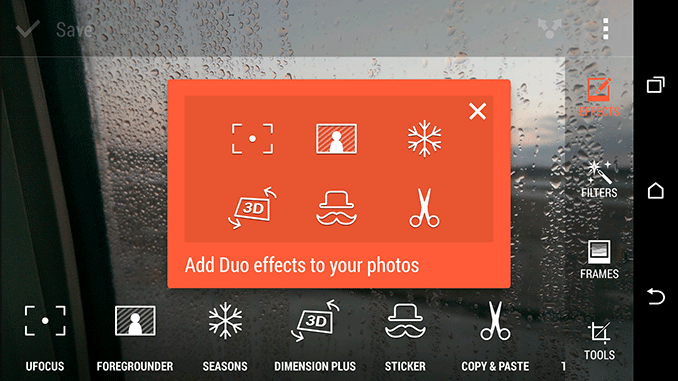
UFocus allows you to change the part of the scene in focus, either using the focus plane of the primary or secondary sensor. This isn’t completely open ended where you can selectively focus on anything in a scene. Instead, you’re basically toggling between focus captured by the primary or secondary sensor with the rest of the scene computationally put in/out of focus from what I can tell. In portraiture you end up with simulated bokeh, giving you heavily blurred backgrounds while keeping your subject in sharp focus. I was sitting across a table from Scott Wasson at a coffee shop and decided to snap a photo of him. Then I fired up UFocus, tapped on his face, and in about a second I had a processed result. I've embedded both images below, click on the buttons to toggle between the two images:

It’s an awesome effect, something that would take considerable time in post normally (not to mention time on a PC). You’ll notice the effect isn’t perfect though. Pay attention to the top of his left shoulder (on the right side of the image). There are clearly some difficulties determining boundaries between foreground and background. Scott then turned the camera on me. With my back to a scene with more depth enabling UFocus around took much longer to process, a matter of a few seconds. The result was even more impressive:

Here I’m clearly separated from the background. You can see some of the limitations of UFocus here as I’m not the only subject in focus. The table to my right is also in focus. It’s still impressive, and something that would be very difficult to do with manual editing (without multiple exposures).
UFocus is easily one of the most compelling applications for the Duo Cam. There’s no real flexibility with the feature though. Moving focus to the background is basically useless. And you can forget about using UFocus for anything other than a portrait. In most other scenes you end up with awkward focus boundaries.
Foregrounder is a pretty neat effect. Similar to UFocus you select a subject to be the focal point, but instead of blurring the rest of the scene HTC uses the depth information to apply shading effects to the rest of the scene. The result can be pretty dramatic if you’re shooting the right scene.
I came across this burrito shop in downtown San Jose, home of the Burritozilla:
The scene itself made for a great photo, but have a look at what happens when I use HTC’s Duo Cam to select the sign and apply an effect to everything physically behind it:
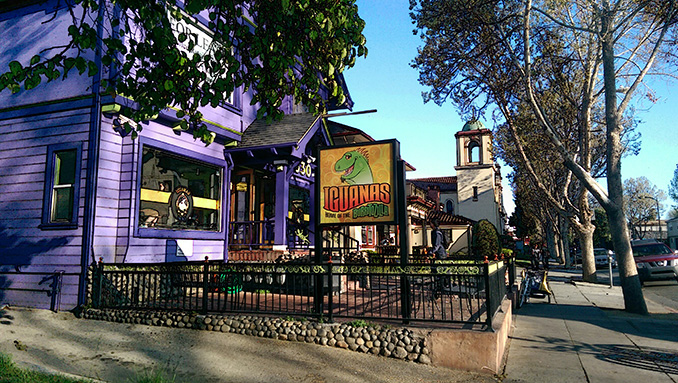
In the right scene the effect can be pretty cool.
Seasons is a bit cheesier although I can see it being quite popular with some folks. Here HTC uses the depth information as well as the image from the second sensor to create a panning effect through a scene while computationally adding in some element of a season (e.g. falling leaves or oversized snowflakes). The effect is best shown off in a video:
Dimension Plus uses the second sensor to enable a parallax effect on a given scene, allowing you to tilt the One in any direction to manipulate the effect. Unlike the other effects, this one can’t be easily exported to a video or other commonly used file format.
Stickers let you apply props to an image:
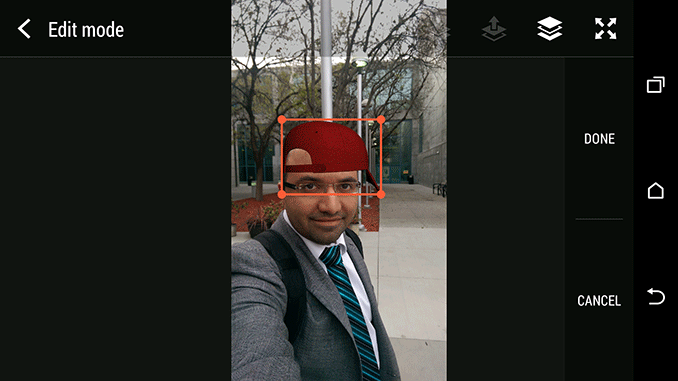

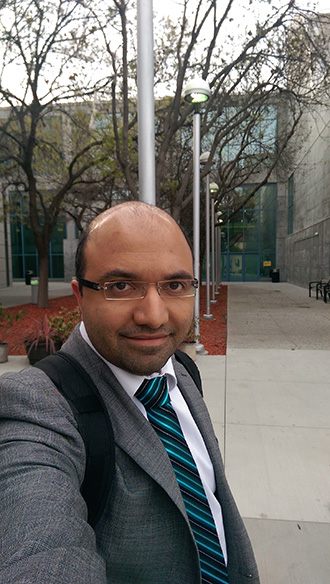 |
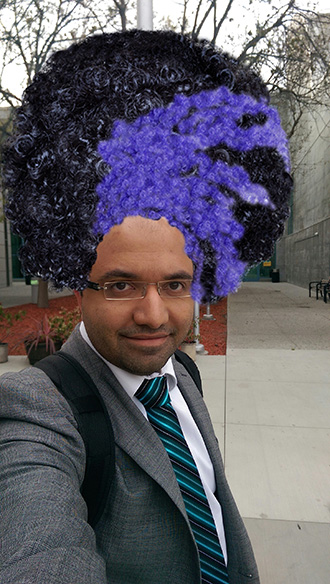 |
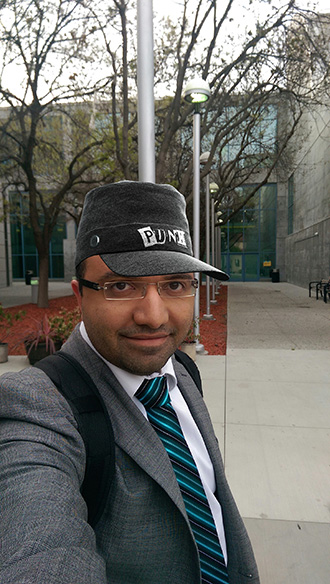 |
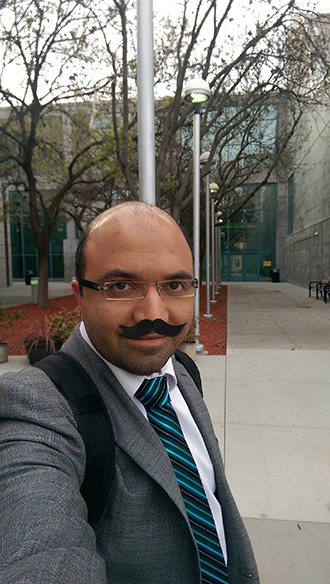 |
Copy and paste lets you quickly copy a person from one image and paste him/her into another. Even here, HTC is using the depth information captured from the secondary sensor to quickly separate the subject from the background. Typically these types of functions involve the user manually selecting the area of interest, here HTC is using the second sensor and a bunch of compute to do that for you. In practice even HTC’s Duo Cam approach requires user intervention, but not a ton if you’re fine with sharing an unpolished image. I figure many of these effects have pretty high comedic value, so something that’s a little less polished likely isn’t a problem.
Applying any of the Duo Cam effects is non destructive to the source image. You can cancel at any time, and hitting save creates a copy of the image - the original always remains intact (images with effects just get a numerical suffix e.g. _2).
There are a number of situations where Duo Cam won’t work. If you cover up the secondary sensor you’ll get a warning, but you’re still able to take shots. I’ve found the secondary sensor is pretty sensitive to things even partially occluding the image. The less obvious situations where Duo Cam disables itself automatically make sense when you think about the architecture of the setup.
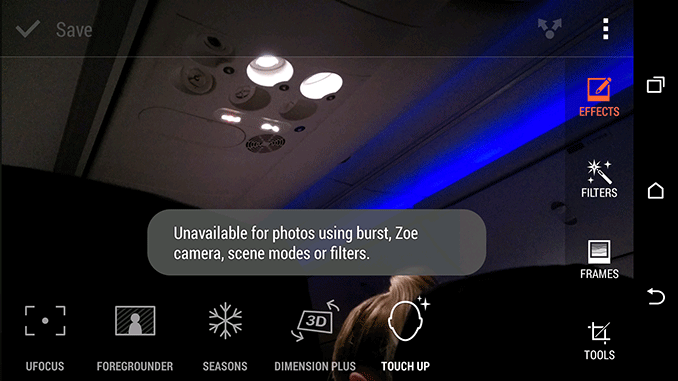
Very low light and macro photography both disable Duo Cam. In the former case you’re dealing with a fairly small 1080p sensor that likely becomes useless as noise levels rise. In the latter case, there’s just nothing left for the secondary sensor to do. Burst mode also disables the second sensor, probably because all of the ISP’s bandwidth is being used for delivering throughput for the primary sensor and can’t be split between the two. Dual capture (front + primary rear sensors in tandem) disables Duo Cam, probably for the same ISP limitations. Finally, Duo Cam also won’t work if the flash fires.
I can see many of the Duo Cam effects being fun things to play around with. I originally wrote them off pretty early on, but just in writing this section alone I can see them resonating very well with some users. They are fun. The good news is that most of the Duo Cam effects can be shared as simple JPEGs or videos with anyone, the bad news is they don’t really do much to further improve image quality. And ultimately that’s one of the biggest challenges with using the M8 to further increase marketshare at the high end.


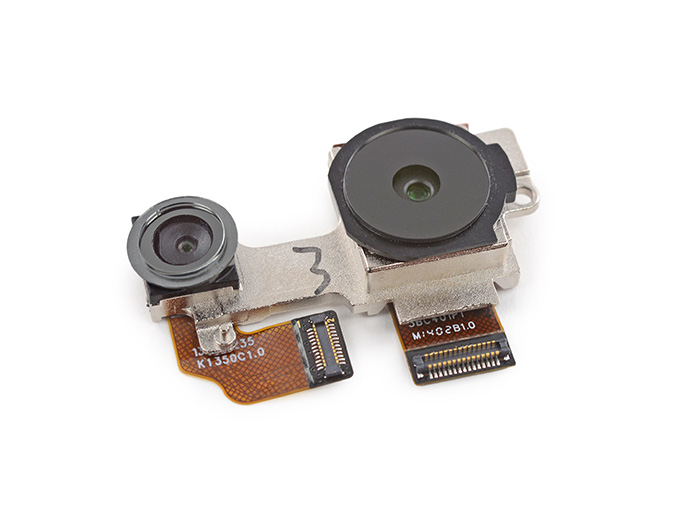
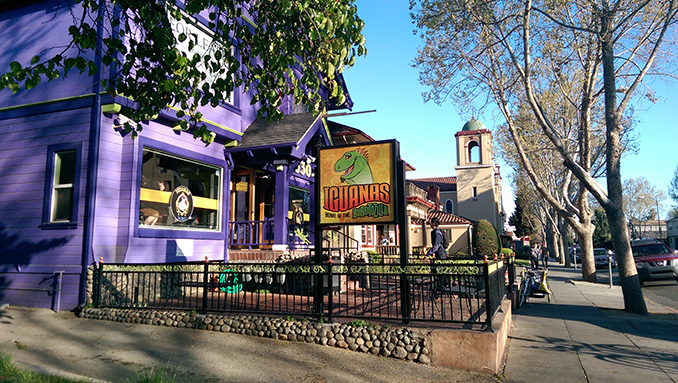
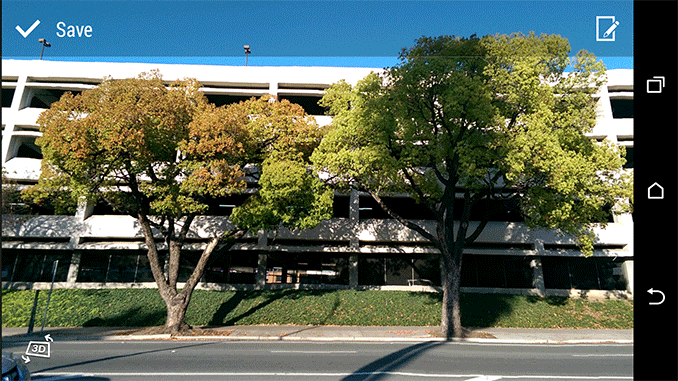








222 Comments
View All Comments
doosh bag - Thursday, March 27, 2014 - link
In order for HTC to build this phone with the "6-8 megapixel" people keep screaming they can't live without, they would've had to raise the price considerably to make the phone profitable. Don't forget HTC's revenues were down almost 50% in Q4 2013 from Q4 2012. It's quite easy for people to sit around in the comment box of someone else's blog and wax intellectual about how to spend HTC's money. If this phone sells like the M7, we may not see a M9.Death666Angel - Friday, March 28, 2014 - link
Lose the second camera, lose the expensive all metal unibody, which obviously people don't need (look at other top selling smartphones) and give me the 6-8MP Ultrapixel sensor for the same price. There, I solved your problem. Now HTC has just done "more of the same" while giving us "less of some stuff". Of a phone that probably wasn't a big hit, or else they would be doing better. I don't understand their strategy at all.evonitzer - Saturday, March 29, 2014 - link
Heck, lose the 801 (who needs that performance anyway), lose the Wifi AC (impossible to find in the wild), cut the screen resolution (nobody needs more than qHD say I) ... what else can I cut and still have a phone? LTE! Get rid of it.Seriously, what's the point of innovating or trying. Just be boring and people will buy it.
jospoortvliet - Sunday, March 30, 2014 - link
I sure as he'll wouldn't have bought it if it was another plasticy piece of crap like the Samsung's... Their strategy is fine, they just need more/better priced midrange phones.hero4hire - Sunday, March 30, 2014 - link
Exactly. It's not like the consumer is footing the bill for the all metal vs plastic. If there was a tradeoff for metal & 4mp or vs plastic 16mp "ultra" it would be worth a discussion. Maybe they could make that phone too. I d bet we find s5 and one (2014) for the same USA subsidy price as is.CoryWeston101 - Monday, March 31, 2014 - link
Cut the metal unibody? You are a daft one.LAWSON72 - Wednesday, March 26, 2014 - link
S5 for water proof and less to worry about since it is plastic, or this for the beautiful metal design, and touchscreen nav buttons. A tough decision, I just know I am getting bored with my S4 and the Nexus 5 sadly is not ever going to be on Verizon, so it is a choice between these two.antef - Wednesday, March 26, 2014 - link
Curious why you're "happy to see a move to nano sim as well." What difference or advantage does it make for the consumer? They can be harder to find on pre-paid carriers. Seems like it only exists due to Apple's relentless desire to always be using something different from everyone else.Braumin - Wednesday, March 26, 2014 - link
Simple. Nano sim in this case made room for dual sim on some models, and likely freed up space for micro SD, although making the body taller likely helped too.Plus the nano sim was made a standard so why not? You can make the argument it's the wrong standard, but it won out.
antef - Thursday, March 27, 2014 - link
I don't think "micro SIM being too big" was ever a reason for excluding things like micro SD slots, that decision is mostly made for other reasons and HTC probably just included it this time to try to differentiate some. I'm okay with a new standard if it's universally available, but until recently and maybe even now that hasn't been the case (again regarding pre-paid carriers).